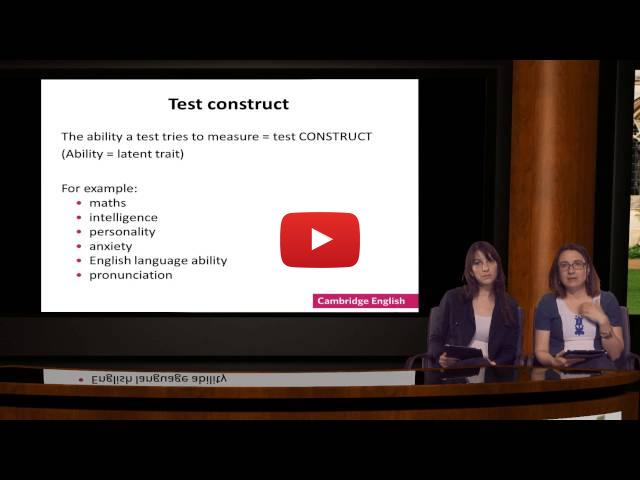Greetings to everyone We can often hear criticism toward most classroom language tests that they do not assess students’ language competence or proficiency because most language teachers do not have the ability to construct good tests. If you would like to know what makes a really good language test, today’s newsletter is right for you!   
What makes a good language test? Testing is a form of assessment and it can take place at any stage of learning. It is often informal, e.g. when you ask your students to recall the words taught in a previous lesson. Formal tests usually evaluate students’ achievements across the curriculum and are often imposed by institutions. It cannot be denied that a great deal of language testing is of very poor quality. Too often language tests have a harmful effect on teaching and learning. Moreover, too often they fail to measure accurately what they are intended to measure. In other words, a test very often lacks some essential features without which it cannot be a valuable learning tool. CRITERIA A written language test is a classic example of formal assessment when students should be aware of being tested for a reason. There are various characteristics that should be taken into account when developing and using a language test. These qualities should be addressed with high consideration in order for a language test to have a positive effect: - Validity. A test is valid if it measures accurately what it is intended to measure. For example, a good test which measures control of grammar should have no difficult lexical items. Often teachers, administrators, and parents want to know information about specific skills students should be developing, such as reading ability or cultural knowledge. It is important to choose a test that focuses on the skill you want to know about. For example, if you want to find out about students’ communicative language ability, a test of only reading and writing may not be enough.
- Reliability. A test is reliable if it gives consistent results. If it is given twice to the same students under the same circumstances, it will produce almost the same results. If it is easy to guess the answers, it is unlikely to be reliable since anyone who does the test has a good chance of scoring highly.
- Practicality. It refers to the economy of time, effort and money in testing. A practical test should be easy to design, easy to administer, easy to mark and easy to interpret its results. The popularity of multiple-choice and gap-fill tests lies in their practicability, i.e. they are easy to conduct.
- Backwash. It is the way tests affect the classroom teaching and learning that leads up to them. Positive backwash refers to expected test effects. For example, a test may encourage students to study more or may promote a connection between standards and instruction. Negative backwash refers to the unexpected, harmful consequences of a test. For example, instruction may focus too heavily on test preparation at the expense of other activities. Backwash from tests can involve individual teachers and students as well as whole classes and programs. Click here for an example of positive backwash in action.
- Authenticity. Language response that students give in the test is appropriate to the language of communication. The test items should be related to the usage of the target language. However, it is quite a controversial issue in ELT.
GUIDELINES FOR TEST PREPARATION How to prepare a good language test? In her book A Course in Language teaching: Practice and Theory, Penny Ur suggests that you list in writing all the material that you want your test to cover before starting creating your own test. Here is a list of tips to consider when you are about to develop your test: BOX 3.4. GUIDELEINES FOR TEST PREPARATION Validity. Check that your items really do test what they are meant to! Clarity. Make sure the instructions for each item are clear. They should usually include a sample item and solution. ‘Do-ability’. The test should be quite do-able: not too difficult, with no trick questions. Ask a colleague to read though it and answer the questions before finalizing. Marking. Decide exactly how you will assess each section of the test, and how much weighting (percentage of the total grade) you will give it. Make the marking system as simple as you can, and inform the testees what it is: write in the number of points allotted after the instructions for each question. Interest. Try to go for interesting content and tasks, in order to make the test more motivating for the learners. Heterogeneity. The test should be such that lower-level students can feel that they are able to do a substantial part of the test, while the higher-level ones have a chance to show what they know. So include both easy and difficult items, and make one or more of the difficult ones optional. © Cambridge University Press 1996 Also, watch the webinar Understanding assessment – what every teacher should know by Cambridge English conducted by Dr Evelina D. Galaczi and Dr Nahal Khabbazbashi. This webinar will explain in everyday language what teachers need to know about key areas of test design. The presenters will also focus on how testing relates to the classroom, and how testing leads to effective teaching and learning. 
For further information about testing in ELT, click the links below: — Understanding Assessment: A Guide for Foreign Language Educators (a tutorial) — Handbook for classroom testing in Peace Corps language programs — 12 Teacher Tips for Writing Good Test Questions — Language Testing: Test types and purposes |